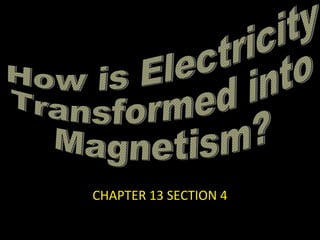4th grade ch. 13 sec. 4 how is electricity transformed
•Download as PPT, PDF•
3 likes•1,771 views
An electromagnet is a coil of wire that produces a magnetic field when electric current passes through it. The magnetic field can be strengthened by using an iron core inside the coil or by increasing the amount of current or number of coils. Electromagnets are common components in electronic devices and generators produce electricity by moving a coil of wire within a magnetic field, with the electric current strength affected by the speed of coil movement and number of coils.
Report
Share
Report
Share

Recommended
Recommended
Wireless power transmission

the slide would help to know about the future mode of energy transmissions techniques. this slide contains the modern examples of implementations...
Non conservative electric field and resulting misconception in kvl

In this project, I demonstrated the invalidity of Kirchhoff's voltage law when applied to circuits having a non-conservative electric field so that the sum of all voltage drops in an electrical loop is not zero.
Moreover, the potential difference between any two points will depend on the path which has been traversed and therefore it will not be unique. I also demonstrated the same by connecting two voltmeters between same two points showing two different readings out of phase with each other.
More Related Content
What's hot
Wireless power transmission

the slide would help to know about the future mode of energy transmissions techniques. this slide contains the modern examples of implementations...
Non conservative electric field and resulting misconception in kvl

In this project, I demonstrated the invalidity of Kirchhoff's voltage law when applied to circuits having a non-conservative electric field so that the sum of all voltage drops in an electrical loop is not zero.
Moreover, the potential difference between any two points will depend on the path which has been traversed and therefore it will not be unique. I also demonstrated the same by connecting two voltmeters between same two points showing two different readings out of phase with each other.
What's hot (19)
Non conservative electric field and resulting misconception in kvl

Non conservative electric field and resulting misconception in kvl
Similar to 4th grade ch. 13 sec. 4 how is electricity transformed
Can you explain how electricity works?

Of course, this suggests that turning off a switch completes a circuit. Electricity travels from the electric wire to the light and then about to the wire. The quantity of energy units utilized during that billing period varies between one month’s reading and the following.
Electromagnetic induction 

Electromagnetic induction builds on the concept of magnets and magnetic fields in grade 10. Most of the work covered here is quite clear and straight forward.
Similar to 4th grade ch. 13 sec. 4 how is electricity transformed (20)
Wireless power transmission via solar power satellite 1(1)

Wireless power transmission via solar power satellite 1(1)
More from hinsz
More from hinsz (20)
5th grade chapter 14 section 4 - what is thermal energy

5th grade chapter 14 section 4 - what is thermal energy
5th grade chapter 14 section 3 - what is light energy

5th grade chapter 14 section 3 - what is light energy
5th grade chapter 14 section 2 - what is sound energy

5th grade chapter 14 section 2 - what is sound energy
4th grade ch. 13 sec. 2 how do electric charges flow

4th grade ch. 13 sec. 2 how do electric charges flow
4th grade ch. 13 sec. 1 how does matter become charged

4th grade ch. 13 sec. 1 how does matter become charged
4th grade unit c ch. 11 lesson 4 how does matter change

4th grade unit c ch. 11 lesson 4 how does matter change
4th grade unit c ch. 11 lesson 3 how do substances mix

4th grade unit c ch. 11 lesson 3 how do substances mix
4th grade ch. 13 sec. 4 how is electricity transformed
- 1. CHAPTER 13 SECTION 4
- 2. ELECTROMAGNETS –a coil of wire with many loops through which an electric current passes • To make the field even stronger, the coil is often wrapped around an iron core
- 3. But Can I Make It Stronger? • You can make an electromagnet stronger by increasing the amount of current running through the wire • Or increasing the number of coils
- 4. ELECTROMAGNETS • Electromagnets are part of many electronic gadgets that you use every day. ex: televisions, fans, computers, and DVD players
- 7. Chapter 13 Section 5
- 8. Electrical Energy • changing a magnetic field generates electricity. • The faster the coiled wire is moved, the stronger the electric current it produces. • The slower the movement, the weaker the current. • The number of coiled loops also affects the strength of the current.
- 9. Generators • machine that creates electric energy by turning coils of wire around powerful magnets
- 10. How Are Generators Powered? • Some use the energy of the wind, while others rely on falling water. • Other generators are powered by steam caused by the hot temperatures deep below Earth’s surface • Or by nuclear energy heating the water.